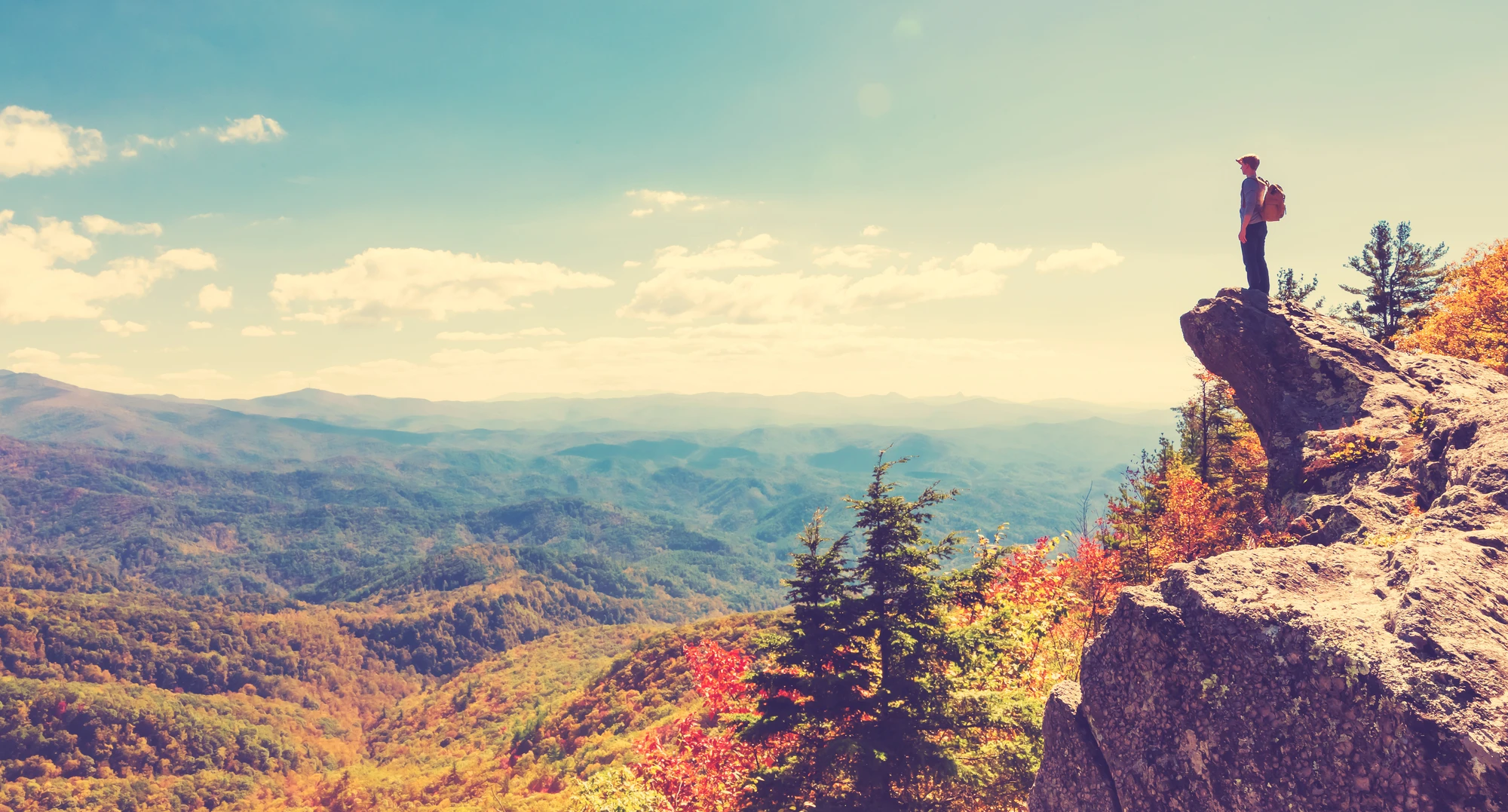Along the Blue Ridges: A Hiker’s Guide to the Great Smoky Mountains
Misty ridgelines, ancient rocks, and trails that make you slow down—how to get the most from America’s most visited national park.
Photo by TierneyMJ
Shutterstock (ID: 510929347)
You arrive before dawn, when the mountains still wear their blue veil. Fog drapes the hollows like a slow tide, and the first rays sketch ridgelines into paper-thin silhouettes. A narrow trail curls away from the parking area—rooted, damp, and honest—and you step into a forest that feels alive in the way only ancient mountains do. The pines murmur; the oaks stand patient and deciduous. Somewhere uphill, a stream dares you to quicken your pace; somewhere below, a valley exhales. This is the Great Smoky Mountains, where trails are less a path than a conversation with the landscape.
Trail Wisdom
Start early for the ridgelines
Begin hikes before 8 a.m. to avoid afternoon thunderstorms, crowds, and the worst of the heat—especially important for long gains like Mount LeConte.
Carry bear-safe storage
Use park-approved canisters or lock your food in vehicle boxes where provided; bears are active and habituation is a major safety concern.
Layer for quick weather shifts
Temperatures can vary dramatically between valleys and summits—pack an insulating midlayer and a lightweight waterproof shell.
Footwear with traction
Expect roots, wet rock, and muddy switchbacks—choose shoes with good soles and ankle support for longer routes.
Local Knowledge
Hidden Gems
- •Cataloochee Valley (wildlife & preserved homesteads)
- •Porters Creek Trail and backcountry cabins for spring wildflowers
Wildlife
Black bear, White-tailed deer
Conservation Note
The park combats threats like invasive pests (balsam woolly adelgid) and stresses from heavy visitation; follow Leave No Trace and use designated facilities to reduce impact.
The park was established in 1934 through a combination of federal purchase and local support, preserving both Appalachian cultural sites and ancient mountain ecosystems.
Seasonal Guide
spring
Best for: Wildflowers, Waterfall volume, Moderate hikes
Challenges: Muddy trails, Variable temperatures, Poison ivy emergence
Spring brings a flush of blooms and high waterfalls; trail conditions can be wet and sticky, so waterproof footwear and gaiters help.
summer
Best for: Backcountry camping, Early-morning ridge hikes, Evening wildlife viewing
Challenges: High heat and humidity, Afternoon storms, Crowded trailheads
Pick early starts and shady routes; carry ample water and be prepared for sudden thunderstorms in the afternoons.
fall
Best for: Fall foliage, Photography, Long clear-sky hikes
Challenges: Peak crowds, Cold nights at elevation, Limited daylight
October is prime for color and clarity—book cabins or campgrounds early and layer up for chilly mornings and nights.
winter
Best for: Quiet summits, Crystal-clear views, Short, crisp day hikes
Challenges: Icy patches, Closed facilities, Limited services in gateway towns
Expect wind and ice near the high points; microspikes and warm layers are essential for summit hikes like Clingmans Dome.
Photographer's Notes
What to Bring
Trail shoes or light backpacking bootsEssential
Sturdy traction protects ankles on roots, rocks, and wet terrain.
Insulating midlayer and waterproof shellEssential
Temperature and weather change fast—layers keep you comfortable from valley to ridge.
3L hydration system or bottlesEssential
Adequate water is crucial on long, steep hikes when sources aren’t reliable.
Map/GPS and headlamp
Navigation and light are critical if you’re delayed; cell service is unreliable inside the park.
Common Questions
Do I need a permit to hike in the Great Smoky Mountains?
Day hiking requires no permit; backcountry camping and shelters require a free permit obtained from the park’s backcountry office.
When is peak fall color?
Peak foliage typically occurs in mid-October, but timing varies with elevation—higher ridgelines change earlier than lower valleys.
Are pets allowed on trails?
Pets are allowed only on a few roads and developed areas; they’re not permitted on most trails or in backcountry zones—check park rules before bringing pets.
How common are black bear encounters and how should I react?
Black bears are common; make noise while hiking, keep a safe distance, never feed wildlife, and secure food properly—if a bear approaches, give it space and back away slowly.
Is Clingmans Dome accessible year-round?
The paved access road to Clingmans Dome can close seasonally due to snow; the summit is reachable by hiking in winter if you’re prepared for ice and wind.
What's the best way to avoid crowds?
Start hikes before sunrise, visit lesser-known areas like Cataloochee Valley, or plan midweek trips outside peak fall weekends.
What to Pack
Water (2–3L), layered clothing (insulation + waterproof), sturdy footwear (traction and ankle support), bear-safe food storage—keeps you hydrated, warm, protected, and compliant with park rules.
Did You Know
Great Smoky Mountains National Park is the most visited national park in the United States, drawing over 10 million visitors annually in recent years.
Quick Travel Tips
1) Arrive early to secure parking at popular trailheads; 2) Download maps offline—cell service is limited; 3) Use bear-resistant storage for all food; 4) Check park alerts for trail and road closures before you go.
Local Flavor
Appalachian craft traditions and contemporary foodways frame the Smokies—look for saltbox cabins, woodcarving shops, and local eateries serving trout, cornbread, and ramp-based dishes; Cherokee heritage centers near the park offer cultural interpretation and artisan work.
Logistics Snapshot
Gateways: Gatlinburg, TN; Cherokee, NC. Park fees: None for entrance. Backcountry permits: Required. Cell service: Limited. Road to Clingmans Dome: Seasonal closures possible.
Sustainability Note
Pack out what you pack in, use established campsites and fire rings where allowed, and store food in approved containers—the park’s ecosystems are fragile and heavy visitation concentrates impact.

